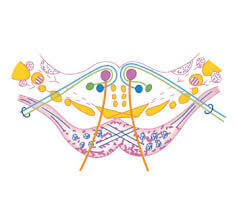
Gray matter: Some cranial nerve nuclei and nuclei of pontine part reticular formation. l Abducent nerve nucleus: It is the nucleus of somatic efferent group. Fibers of abducent (VIth cranial) nerve arising from this nucleus supply lateral rectus muscle of eyeball which is developed from preoccipital myotome of paraaxial mesoderm. This nucleus is situated deep to a paramedian bulge adjacent to posterior median sulcus. The bulge is called facial colliculus because the surface of abducent nucleus is winded by fibers of facial nerve.
- Motor nucleus of facial nerve: This is the nucleus of special visceral efferent column which supplies muscles developed from mesoderm of second branchial arch.efferent nucleus of facial nerve, situated lateral to motor nucleus of facial nerve. It has a component called lacrimatory nucleus. Parasympathetic secretomotor fibers from these nuclei are directed to supply to submandibular and sublingual salivary glands, and lacrimal gland.
- Spinal nucleus of trigeminal nerve: This is exteroceptive variety of general somatic afferent nucleus of trigeminal nerve, which receives pain and temperature sensation from skin of face. Though called spinal nucleus, main part of this nucleus extends throughout whole length of medulla oblongata. Its lower end extends upto 2nd cervical segments of spinal cord and upper end extends to the lower half of pons. This nucleus is situated in the lateral part of tegmentum of lower end of pons. It receives sensory fibers of trigeminal nerve which caps dorsal aspect of the nucleus to form spinal tract of the nerve.
- Vestibular nucleus of vestibulocochlear nerve:
This is proprioceptive type of special somatic afferent nucleus of vestibulocochlear nerve. It is composed of superior, lateral, medial and inferior parts. Vestibular nucleus is situated partly in lower part of pons and upper part of medulla. It is placed in superficial plane at the lateral angle of pontomedullary junction. This nucleus receives afferent fibers which are nothing but vestibular fibers of VIIIth cranial nerve carrying sense of equilibrium or balance.
Efferent fibers are:
- Vestibulocerebellar fibers
- Vestibulospinal fibers
- Medial longitudinal bundle: Which connect vestibular nucleus with nuclei of IIIrd, IVth, VIth and XIth cranial nerves and anterior horn cells of upper cervical segments of spinal cord. It causes reflex movement of eyeball and head and neck in response to change of position body. Cochlear nucleus of vestibulocochlear nerve: It is exteroceptive type of special somatic afferent nucleus of cochlear component of vestibulocochlear nerve. It is made up of dorsal and ventral components lying dorsal and ventral to inferior cerebellar peduncle fibers at the level of pontomedullary junction.
Connections of cochlear nuclei:
- Afferent: Fibers of cochlear component of vestibulocochlear nerve carrying sense of hearing from receptors (organ of Corti) at internal ear relay in dorsal and ventral cochlear nuclei.
- Efferent: Axons of cochlear nuclei will have to reach upto corresponding thalamic nuclei to carry impulse to sensory area of cerebral cortex. While ascending through central core of brainstem to reach the thalamus, at the level of lower end of pons, relayin a nucleus, called nucleus of trapezoid body. Before the relay, axons of both dorsal and ventral cochlear nuclei partly remain in the same side, partly cross the midline to relay in nucleus of trapezoid body of opposite side. In horizontal section, the fibers show a trapezoid shape, for which the decussating and nondecussating fibers are called trapezoid body, so the nucleus is also accordingly named.
Source: Easy and Interesting Approach to Human Neuroanatomy (Clinically Oriented) (2014)